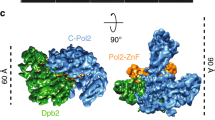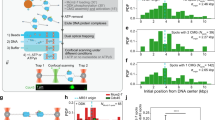Abstract
The pre-initiation complex (pre-IC) has been proposed for two decades as an intermediate right before the maturation of the eukaryotic DNA replication fork. However, its existence and biochemical nature remain enigmatic. Here, through combining several enrichment strategies, we are able to isolate an endogenous dimeric CMG-containing complex (designated as d-CMG) distinct from traditional single CMG (s-CMG) and in vitro reconstituted dimeric CMG. D-CMG is assembled upon entry into the S phase and shortly matures into s-CMG/replisome, leading to the fact that only ~ 5% of the total CMG-containing complexes can be detected as d-CMG in vivo. Mass spectra reveal that RPA and DNA Pol α/primase co-purify with s-CMG, but not with d-CMG. Consistently, the former fraction is able to catalyze DNA unwinding and de novo synthesis, while the latter catalyzes neither. The two CMGs in d-CMG display flexibly orientated conformations under an electronic microscope. When DNA Pol α-primase is inactivated, d-CMG % rose up to 29%, indicating an incomplete pre-IC/fork transition. These findings reveal biochemical properties of the d-CMG/pre-IC and provide in vivo evidence to support the pre-IC/fork transition as a bona fide step in replication initiation.







Similar content being viewed by others
References
Parker MW, Botchan MR, Berger JM (2017) Mechanisms and regulation of DNA replication initiation in eukaryotes. Crit Rev Biochem Mol Biol 52(2):107–144. https://doi.org/10.1080/10409238.2016.1274717
Bleichert F, Botchan MR, Berger JM (2017) Mechanisms for initiating cellular DNA replication. Science. https://doi.org/10.1126/science.aah6317
Evrin C, Clarke P, Zech J, Lurz R, Sun J, Uhle S, Li H, Stillman B, Speck C (2009) A double-hexameric MCM2-7 complex is loaded onto origin DNA during licensing of eukaryotic DNA replication. Proc Natl Acad Sci 106(48):20240–20245. https://doi.org/10.1073/pnas.0911500106
Remus D, Beuron F, Tolun G, Griffith JD, Morris EP, Diffley JF (2009) Concerted loading of Mcm2-7 double hexamers around DNA during DNA replication origin licensing. Cell 139(4):719–730. https://doi.org/10.1016/j.cell.2009.10.015
Li N, Zhai Y, Zhang Y, Li W, Yang M, Lei J, Tye B-K, Gao N (2015) Structure of the eukaryotic MCM complex at 3.8 A. Nature 524(7564):186–191. https://doi.org/10.1038/nature14685
Coster G, Diffley JFX (2017) Bidirectional eukaryotic DNA replication is established by quasi-symmetrical helicase loading. Science 357(6348):314–318. https://doi.org/10.1126/science.aan0063
Moyer SE, Lewis PW, Botchan MR (2006) Isolation of the Cdc45/Mcm2-7/GINS (CMG) complex, a candidate for the eukaryotic DNA replication fork helicase. Proc Natl Acad Sci USA 103(27):10236–10241. https://doi.org/10.1073/pnas.0602400103
Gambus A, Jones RC, Sanchez-Diaz A, Kanemaki M, van Deursen F, Edmondson RD, Labib K (2006) GINS maintains association of Cdc45 with MCM in replisome progression complexes at eukaryotic DNA replication forks. Nat Cell Biol 8(4):358–366. https://doi.org/10.1038/ncb1382
Pacek M, Tutter AV, Kubota Y, Takisawa H, Walter JC (2006) Localization of MCM2-7, Cdc45, and GINS to the site of DNA unwinding during eukaryotic DNA replication. Mol Cell 21(4):581–587. https://doi.org/10.1016/j.molcel.2006.01.030
Ilves I, Petojevic T, Pesavento JJ, Botchan MR (2010) Activation of the MCM2-7 helicase by association with Cdc45 and GINS proteins. Mol Cell 37(2):247–258. https://doi.org/10.1016/j.molcel.2009.12.030
Yardimci H, Loveland AB, Habuchi S, van Oijen AM, Walter JC (2010) Uncoupling of sister replisomes during eukaryotic DNA replication. Mol Cell 40(5):834–840. https://doi.org/10.1016/j.molcel.2010.11.027
Costa A, Ilves I, Tamberg N, Petojevic T, Nogales E, Botchan MR, Berger JM (2011) The structural basis for MCM2-7 helicase activation by GINS and Cdc45. Nat Struct Mol Biol 18(4):471–477. https://doi.org/10.1038/nsmb.2004
Riera A, Barbon M, Noguchi Y, Reuter LM, Schneider S, Speck C (2017) From structure to mechanism—understanding initiation of DNA replication. Genes Dev 31(11):1073–1088. https://doi.org/10.1101/gad.298232.117
O’Donnell ME, Li H (2018) The ring-shaped hexameric helicases that function at DNA replication forks. Nat Struct Mol Biol. https://doi.org/10.1038/s41594-018-0024-x
Sheu YJ, Stillman B (2006) Cdc7-Dbf4 phosphorylates MCM proteins via a docking site-mediated mechanism to promote S phase progression. Mol Cell 24(1):101–113. https://doi.org/10.1016/j.molcel.2006.07.033
Sheu YJ, Stillman B (2010) The Dbf4-Cdc7 kinase promotes S phase by alleviating an inhibitory activity in Mcm4. Nature 463(7277):113–117. https://doi.org/10.1038/nature08647
Heller RC, Kang S, Lam WM, Chen S, Chan CS, Bell SP (2011) Eukaryotic origin-dependent DNA replication in vitro reveals sequential action of DDK and S-CDK kinases. Cell 146(1):80–91. https://doi.org/10.1016/j.cell.2011.06.012
Tanaka S, Araki H (2013) Helicase activation and establishment of replication forks at chromosomal origins of replication. Cold Spring Harb Perspect Bio 5(12):a010371. https://doi.org/10.1101/cshperspect.a010371
Deegan TD, Yeeles JT, Diffley JF (2016) Phosphopeptide binding by Sld3 links Dbf4-dependent kinase to MCM replicative helicase activation. EMBO J. https://doi.org/10.15252/embj.201593552
Fang D, Cao Q, Lou H (2016) Sld3-MCM interaction facilitated by Dbf4-dependent kinase defines an essential step in eukaryotic DNA replication initiation. Front Microbiol 7:885. https://doi.org/10.3389/fmicb.2016.00885
Siddiqui K, On KF, Diffley JF (2013) Regulating DNA replication in eukarya. Cold Spring Harb Perspect. https://doi.org/10.1101/cshperspect.a012930
Costa A, Renault L, Swuec P, Petojevic T, Pesavento JJ, Ilves I, MacLellan-Gibson K, Fleck RA, Botchan MR, Berger JM (2014) DNA binding polarity, dimerization, and ATPase ring remodeling in the CMG helicase of the eukaryotic replisome. Elife 3:e03273. https://doi.org/10.7554/elife.03273
Quan Y, Xia Y, Liu L, Cui J, Li Z, Cao Q, Chen XS, Campbell JL, Lou H (2015) Cell-cycle-regulated interaction between Mcm10 and double hexameric Mcm2-7 is required for helicase splitting and activation during S Phase. Cell Rep 13(11):2576–2586. https://doi.org/10.1016/j.celrep.2015.11.018
Miyazawa-Onami M, Araki H, Tanaka S (2017) Pre-initiation complex assembly functions as a molecular switch that splits the Mcm27 double hexamer. EMBO Rep 18(10):1752–1761
Douglas ME, Ali FA, Costa A, Diffley JFX (2018) The mechanism of eukaryotic CMG helicase activation. Nature 555:265. https://doi.org/10.1038/nature25787
Zou L, Stillman B (1998) Formation of a preinitiation complex by S-phase cyclin CDK-dependent loading of Cdc45p onto chromatin. Science 280(5363):593–596. https://doi.org/10.1126/science.280.5363.593
Douglas ME, Diffley JFX (2016) Recruitment of Mcm10 to sites of replication initiation requires direct binding to the minichromosome maintenance (MCM) complex. J Biol Chem 291(11):5879–6888. https://doi.org/10.1074/jbc.M115.707802
Yeeles JT, Deegan TD, Janska A, Early A, Diffley JF (2015) Regulated eukaryotic DNA replication origin firing with purified proteins. Nature 519(7544):431–435. https://doi.org/10.1038/nature14285
Gambus A, van Deursen F, Polychronopoulos D, Foltman M, Jones RC, Edmondson RD, Calzada A, Labib K (2009) A key role for Ctf4 in coupling the MCM2-7 helicase to DNA polymerase alpha within the eukaryotic replisome. EMBO J 28(19):2992–3004. https://doi.org/10.1038/emboj.2009.226
Simon AC, Zhou JC, Perera RL, van Deursen F, Evrin C, Ivanova ME, Kilkenny ML, Renault L, Kjaer S, Matak-Vinkovic D, Labib K, Costa A, Pellegrini L (2014) A Ctf4 trimer couples the CMG helicase to DNA polymerase alpha in the eukaryotic replisome. Nature 510(7504):293–297. https://doi.org/10.1038/nature13234
Villa F, Simon AC, Ortiz Bazan MA, Kilkenny ML, Wirthensohn D, Wightman M, Matak-Vinkovic D, Pellegrini L, Labib K (2016) Ctf4 is a hub in the eukaryotic replisome that Links multiple CIP-box proteins to the CMG helicase. Mol Cell. https://doi.org/10.1016/j.molcel.2016.06.009
Perera RL, Torella R, Klinge S, Kilkenny ML, Maman JD, Pellegrini L (2013) Mechanism for priming DNA synthesis by yeast DNA polymerase alpha. Elife 2:e00482. https://doi.org/10.7554/eLife.00482
Georgescu R, Yuan Z, Bai L, de Luna Almeida Santos R, Sun J, Zhang D, Yurieva O, Li H, O’Donnell ME (2017) Structure of eukaryotic CMG helicase at a replication fork and implications to replisome architecture and origin initiation. Proc Natl Acad Sci USA. https://doi.org/10.1073/pnas.1620500114
Yuan Z, Bai L, Sun J, Georgescu R, Liu J, O’Donnell ME, Li H (2016) Structure of the eukaryotic replicative CMG helicase suggests a pumpjack motion for translocation. Nat Struct Mol Biol. https://doi.org/10.1038/nsmb.3170
Sun J, Shi Y, Georgescu RE, Yuan Z, Chait BT, Li H, O’Donnell ME (2015) The architecture of a eukaryotic replisome. Nat Struct Mol Biol 22(12):976–982. https://doi.org/10.1038/nsmb.3113
Zhou JC, Janska A, Goswami P, Renault L, Abid Ali F, Kotecha A, Diffley JF, Costa A (2017) CMG-Pol epsilon dynamics suggests a mechanism for the establishment of leading-strand synthesis in the eukaryotic replisome. Proc Natl Acad Sci USA 114(16):4141–4146. https://doi.org/10.1073/pnas.1700530114
Maric M, Maculins T, De Piccoli G, Labib K (2014) Cdc48 and a ubiquitin ligase drive disassembly of the CMG helicase at the end of DNA replication. Science 346(6208):1253596. https://doi.org/10.1126/science.1253596
Priego Moreno S, Bailey R, Campion N, Herron S, Gambus A (2014) Polyubiquitylation drives replisome disassembly at the termination of DNA replication. Science 346(6208):477–481. https://doi.org/10.1126/science.1253585
Dewar JM, Budzowska M, Walter JC (2015) The mechanism of DNA replication termination in vertebrates. Nature 525:345. https://doi.org/10.1038/nature14887
Xia Y, Niu Y, Cui J, Fu Y, Chen X, Lou H, Cao Q (2015) The helicase activity of hyperthermophilic archaeal MCM is enhanced at high temperatures by lysine methylation. Front Microbiol 6:1247. https://doi.org/10.3389/fmicb.2015.01247
Chi H, He K, Yang B, Chen Z, Sun R-X, Fan S-B, Zhang K, Liu C, Yuan Z-F, Wang Q-H, Liu S-Q, Dong M-Q, He S-M (2015) pFind–Alioth: a novel unrestricted database search algorithm to improve the interpretation of high-resolution MS/MS data. J Proteomics 125:89–97. https://doi.org/10.1016/j.jprot.2015.05.009
Tang G, Peng L, Baldwin PR, Mann DS, Jiang W, Rees I, Ludtke SJ (2007) EMAN2: an extensible image processing suite for electron microscopy. J Struct Biol 157(1):38–46. https://doi.org/10.1016/j.jsb.2006.05.009
Scheres SHW (2012) RELION: implementation of a Bayesian approach to cryo-EM structure determination. J Struct Biol 180(3):519–530. https://doi.org/10.1016/j.jsb.2012.09.006
Pettersen EF, Goddard TD, Huang CC, Couch GS, Greenblatt DM, Meng EC, Ferrin TE (2004) UCSF Chimera—A visualization system for exploratory research and analysis. J Comput Chem 25(13):1605–1612. https://doi.org/10.1002/jcc.20084
Acknowledgements
We thank Dr. Costa for sharing unpublished data and superposed CMG-Ctf4 structure shown in Fig. 6e; Dr. Karim Labib for insightful discussion; Drs. Karim Labib, Stephen Bell, and Li-Lin Du for reagents; Drs. Ning Gao, Hao Wu, Qun He, Yisui Xia, Ms. Yawen Bai, and members of the Lou lab for help and comments on the manuscript.
Funding
This work was supported by the National Natural Science Foundation of China (http://www.nsfc.gov.cn/) 31630005 and 31770084 to HL, 31771382 to QC, 31800066 to JZ; the China Postdoctoral Science Foundation (http://jj.chinapostdoctor.org.cn/) 2018M640201 to JZ; the National Basic Research Program (973 Program) of China (http://www.most.gov.cn/) 2014CB849801 to MQD; Program for Extramural Scientists of the State Key Laboratory of Agrobiotechnology (http://en.cau.edu.cn/colleges/biological-science/) (2018SKLAB6-5) to MQD; Opening Project of the State Key Laboratory of Microbial Resources (http://english.im.cas.cn/) to HL.
Author information
Authors and Affiliations
Corresponding author
Ethics declarations
Conflict of interest
The authors declare no competing financial interests.
Additional information
Publisher's Note
Springer Nature remains neutral with regard to jurisdictional claims in published maps and institutional affiliations.
Electronic supplementary material
Below is the link to the electronic supplementary material.
Rights and permissions
About this article
Cite this article
Liu, L., Zhang, Y., Zhang, J. et al. Characterization of the dimeric CMG/pre-initiation complex and its transition into DNA replication forks. Cell. Mol. Life Sci. 77, 3041–3058 (2020). https://doi.org/10.1007/s00018-019-03333-9
Received:
Revised:
Accepted:
Published:
Issue Date:
DOI: https://doi.org/10.1007/s00018-019-03333-9




